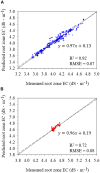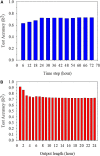Forecasting Root-Zone Electrical Conductivity of Nutrient Solutions in Closed-Loop Soilless Cultures via a Recurrent Neural Network Using Environmental and Cultivation Information
- PMID: 29977249
- PMCID: PMC6021533
- DOI: 10.3389/fpls.2018.00859
Forecasting Root-Zone Electrical Conductivity of Nutrient Solutions in Closed-Loop Soilless Cultures via a Recurrent Neural Network Using Environmental and Cultivation Information
Abstract
In existing closed-loop soilless cultures, nutrient solutions are controlled by the electrical conductivity (EC) of the solution. However, the EC of nutrient solutions is affected by both growth environments and crop growth, so it is hard to predict the EC of nutrient solution. The objective of this study was to predict the EC of root-zone nutrient solutions in closed-loop soilless cultures using recurrent neural network (RNN). In a test greenhouse with sweet peppers (Capsicum annuum L.), data were measured every 10 s from October 15 to December 31, 2014. Mean values for every hour were analyzed. Validation accuracy (R2) of a single-layer long short-term memory (LSTM) was 0.92 and root-mean-square error (RMSE) was 0.07, which were the best results among the different RNNs. The trained LSTM predicted the substrate EC accurately at all ranges. Test accuracy (R2) was 0.72 and RMSE was 0.08, which were lower than values for the validation. Deep learning algorithms were more accurate when more data were added for training. The addition of other environmental factors or plant growth data would improve model robustness. A trained LSTM can control the nutrient solutions in closed-loop soilless cultures based on predicted future EC. Therefore, the algorithm can make a planned management of nutrient solutions possible, reducing resource waste.
Keywords: black box modeling; environmental factor; long short-term memory; machine learning; sweet pepper.
Figures







Similar articles
-
Long short-term memory for a model-free estimation of macronutrient ion concentrations of root-zone in closed-loop soilless cultures.Plant Methods. 2019 May 28;15:59. doi: 10.1186/s13007-019-0443-7. eCollection 2019. Plant Methods. 2019. PMID: 31160918 Free PMC article.
-
Theoretical and Experimental Analyses of Nutrient Control in Electrical Conductivity-Based Nutrient Recycling Soilless Culture System.Front Plant Sci. 2021 May 24;12:656403. doi: 10.3389/fpls.2021.656403. eCollection 2021. Front Plant Sci. 2021. PMID: 34108979 Free PMC article.
-
Multi-step ahead forecasting of electrical conductivity in rivers by using a hybrid Convolutional Neural Network-Long Short-Term Memory (CNN-LSTM) model enhanced by Boruta-XGBoost feature selection algorithm.Sci Rep. 2024 Jul 1;14(1):15051. doi: 10.1038/s41598-024-65837-0. Sci Rep. 2024. PMID: 38951605 Free PMC article.
-
Experimental model and neural network based electrical conductivity estimation in soilless culture system.Acta Hortic. 1996 Dec;440:344-9. doi: 10.17660/actahortic.1996.440.60. Acta Hortic. 1996. PMID: 11541580
-
Hydroponic Solutions for Soilless Production Systems: Issues and Opportunities in a Smart Agriculture Perspective.Front Plant Sci. 2019 Jul 24;10:923. doi: 10.3389/fpls.2019.00923. eCollection 2019. Front Plant Sci. 2019. PMID: 31396245 Free PMC article. Review.
Cited by
-
Selection of nitrogen responsive root architectural traits in spinach using machine learning and genetic correlations.Sci Rep. 2021 May 5;11(1):9536. doi: 10.1038/s41598-021-87870-z. Sci Rep. 2021. PMID: 33953221 Free PMC article.
-
Predictive Modeling of a Leaf Conceptual Midpoint Quasi-Color (CMQ) Using an Artificial Neural Network.Sensors (Basel). 2020 Jul 15;20(14):3938. doi: 10.3390/s20143938. Sensors (Basel). 2020. PMID: 32679776 Free PMC article.
-
Empowering vertical farming through IoT and AI-Driven technologies: A comprehensive review.Heliyon. 2024 Jul 23;10(15):e34998. doi: 10.1016/j.heliyon.2024.e34998. eCollection 2024 Aug 15. Heliyon. 2024. PMID: 39157372 Free PMC article. Review.
-
Performance Analysis of Time Series Deep Learning Models for Climate Prediction in Indoor Hydroponic Greenhouses at Different Time Intervals.Plants (Basel). 2023 Jun 14;12(12):2316. doi: 10.3390/plants12122316. Plants (Basel). 2023. PMID: 37375941 Free PMC article.
-
Fertigation control system based on the mariotte siphon.Sci Rep. 2024 Oct 9;14(1):23573. doi: 10.1038/s41598-024-75057-1. Sci Rep. 2024. PMID: 39384973 Free PMC article.
References
-
- Adavanne S., Pertilä P., Virtanen T. (2017). Sound event detection using spatial features and convolutional recurrent neural network. arXiv:1706.02291 [Preprint].
-
- Ahn T. I., Shin J. W., Son J. E. (2010). Analysis of changes in ion concentration with time and drainage ratio under EC-based nutrient control in closed-loop soilless culture for sweet pepper plants (Capsicum annum L.’Boogie’). J. Bioenviron. Cont. 19 298–304.
-
- Baille M., Baille A., Laury J. C. (1994). A simplified model for predicting evapotranspiration rate of nine ornamental species vs. climate factors and leaf area. Sci. Hortic. 59 217–232. 10.1016/0304-4238(94)90015-9 - DOI
-
- Beltramo T., Ranzan C., Hinrichs J., Hitzmann B. (2016). Artificial neural network prediction of the biogas flow rate optimised with an ant colony algorithm. Biosyst. Eng. 143 68–78. 10.1016/j.biosystemseng.2016.01.006 - DOI
-
- Cho K., van Merriënboer B., Gulcehre C., Bahdanau D., Bougares F., Schwenk H., et al. (2014). Learning phrase representations using RNN encoder-decoder for statistical machine translation. arXiv:1406.1078 [Preprint] 10.3115/v1/d14-1179 - DOI
LinkOut - more resources
Full Text Sources
Other Literature Sources

